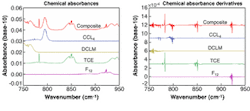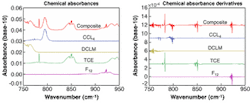Quantum-cascade lasers enable infrared sensors
Quantum-cascade lasers (QCLs) are semiconductor-injection lasers based on intersubband transitions in a multiple-quantum-well heterostructure. They are designed using band-structure engineering and grown by molecular beam epitaxy. The emission wavelength of a QCL is primarily a function of quantum-well thickness—thinner quantum wells lead to shorter wavelengths—and is essentially independent of the material bandgap. Quantum-cascade lasers can be designed to operate at any wavelength from 3.5 µm (infrared) to 67 µm (terahertz region) and are continuously tunable through ranges of a few inverse centimeters.1, 2, 3 This capability makes them well suited for spectroscopy in the infrared (see Laser Focus World, August 1999, p. 40).
Laser-based chemical sensing
Chemical sensors based on optical-absorption spectroscopy determine the presence of chemical vapors (analytes) by comparing light-absorption spectra from multiple air samples. The spectra can be measured remotely with lidar or passive spectrometers, or in air samples drawn into optical cavities or other chambers. The spectra of analytes and interferents are fit to the measured spectrum of each air sample to determine the best fitting concentration combination. A sample is determined to contain a given analyte when the fit yields a concentration that is statistically greater than ambient.
The sensitivity (minimum detectable analyte burden), and selectivity (susceptibility to interferents) of a sensor are therefore determined by ability to separate spectral differences due to the analyte concentration from spectral differences due to instrument noise or fluctuations in ambient conditions. Choosing analyte spectral features with the best combination of absorption strength and spectral uniqueness is therefore key to sensor performance. Common instrument noise sources are laser speckle; fluctuations in laser power, wavelength, or phase; signal shot noise; calibration errors; and photodetector or amplifier noise. Relevant ambient fluctuations include variations in atmospheric chemical content or temperature and variations in ground surface materials, roughness, geometry, or temperatures.
The natural atmosphere is relatively free of absorption features in spectral windows lying from 3 to 5 µm (mid-wave infrared, or MWIR), and 8 to 13 µm (long-wave infrared, or LWIR). At atmospheric pressure, the most distinctive spectral features are "Q-branch" absorptions resulting from multiple DJ = 0 transitions with nearly the same energy. Many important molecules have Q-branch absorptions that can be as narrow as 0.1 cm-1 at atmospheric pressure in the LWIR window. To date, LWIR laser-wavelength tuning and power have been inadequate for exploitation of most Q-branch spectral features, except at coincidental overlaps with carbon dioxide or other gas laser lines. Inadequate laser stability, tuning, and modulation characteristics have also impeded use of frequency-modulation techniques sensitive to narrow features and their slopes, or exploitation of the greater spectral uniqueness available at reduced pressures. As noted above, QCLs can be designed to operate at any center wavelength in these windows, and are continuously tunable through ranges of a few inverse centimeters. Therefore, QCLs are being used in a wide range of sensor development research.
FM spectroscopy
The derivatives of molecular spectra often contain narrower, more distinctive features than the spectra themselves (see Fig. 1).4 The time dependence of an amplitude-modulated (AM) and frequency-modulated (FM) laser beam's electric field, E(t), can be described as a carrier at frequency wo, plus a series of terms shifted in frequency from the carrier by harmonics of the modulation frequency ωm5.
null
Here M is the AM coefficient, ß is the phase-modulation index, and Jn are Bessel functions.
Photodetectors respond to the electric field squared, so modulated light generates beat signals at all harmonics of the modulation frequency. Photodetectors illuminated with pure FM laser light (M = 0) produce only a DC (direct current, or constant in time) signal because the beat frequencies between all terms in the above equation cancel. If the relative amplitudes or phases of the terms in the equation are changed by a molecular absorption, the beats no longer cancel, and the photodetector produces harmonics of the modulation frequency ωm. In the limit that the modulation frequency and the product of modulation frequency times phase modulation index are much less than the width of a molecular absorption feature, the signal at the nth harmonic of ωm is proportional to the nth derivative of the absorption spectrum with respect to frequency. Continuous segments of derivative spectra are mapped by tuning the laser fundamental ωo while modulating the laser at ωm. Because the signals occur at precise frequencies chosen by the experimenter, narrowband detectors and amplifiers are easily optimized, and noise is filtered effectively.
Quantum-cascade lasers are ideal for FM spectroscopy because they are stable, easily modulated by modulating their drive currents, sufficiently powerful for short-range remote sensing, and provide access to LWIR center frequencies matching distinctive molecular absorptions with the steep slopes needed to generate large amplitude or phase differences between harmonics. Remote and sampling sensors using FM spectroscopy and other sensing techniques with QCLs are under development.
Cavity-enhanced sensors
When air samples can be drawn into optical cavities for analysis, important sources of noise due to ambient fluctuations are eliminated. Optical cavities can greatly increase the path length of laser light through the sample, with proportional increases in signal-to-noise ratios. Samples also can be interrogated at reduced pressure, which reduces interference due to pressure broadening with little loss of peak absorption strength. Significant drawbacks to cavity-enhanced sensing (CES) are errors caused by optical fringing effects and noise from jitter between the laser frequency and the frequencies of optical-cavity transmission peaks. Locking laser and cavity frequencies with servo loops, cavity-ringdown spectrometry, and FM techniques reduce these effects.
In 1998, noise-equivalent absorption sensitivities equivalent to one-tenth the absorption of a single atom were obtained using a cavity-enhanced FM spectroscopy technique called noise-immune, cavity-enhanced, optical heterodyne molecular spectroscopy (NICE-OHMS), implemented with an Nd:YAG laser at 1.06 µm.6 This technique promises the ability to detect compounds that are hard to detect by other means due to low vapor pressures, such as explosives or narcotics. For chemical sensing, it's more desirable to implement NICE-OHMS in the LWIR to take advantage of distinctive molecular absorption features. The performance of lasers, detectors, and optics are poorer in the LWIR, but NICE-OHMS and other CES techniques hold potential for breakthroughs. In 2001, two LWIR QCLs were locked to optical cavities and mixed on a detector, achieving a beat linewidth of 5.6 Hz.7 These lasers were used to demonstrate NICE-OHMS and other CES techniques in the LWIR.8
QCL system development
Most applications discussed above require QCLs and photodetectors combined with infrared optical components such as cavities, lenses, polarizers, modulators, isolators, beamsplitters, beam couplers, QC amplifiers, or wavelength multiplexers to form QC transmitters capable of meeting stringent laser performance requirements. In addition to the cavity-locking successes described above, transmitter development efforts are demonstrating injection locking, amplification, and AM suppression.8
For many applications, QC transmitter volumes of 100 in.3 or less are essential. The small dimensions of QCLs enable such miniaturization (see Fig. 2), but conventional MWIR and LWIR optical components are bulky and expensive. Given the small dimensions of QCL facets relative to infrared wavelengths, the divergence of QCL beams is great enough that even coupling QCLs to optical components is challenging. At shorter wavelengths, most of the optical components mentioned above are miniaturized with fibers or waveguides. Development of the optical cavities, frequency references, single-mode waveguides, and waveguide devices needed to miniaturize QC transmitters is in progress.8
Acknowledgments
The author gratefully acknowledges many years of collaboration with Federico Capasso (now at Harvard University) and Claire Gmachl (Bell Laboratories) and funding from the U.S. Dept. of Energy and DARPA/MTO.
REFERENCES
- C. Gmachl et al., Rep. Prog. Phys. 64, 1533 (2001).
- M. Beck et al., Science 295(5553), 301 (2002).
- Kohler et al., Appl. Phys. Lett. 82(10), 1518 (2003).
- S. Sharpe et al., Proc. SPIE 4577, 12 (2001).
- J. A. Silver, Appl. Optics 31(6), 707 (1992).
- J. Ye et al., J. Opt. Soc. Am B 15(1), 6 (1998).
- M. S. Taubman et al., Optics Lett. 27, 2164 (2002).
- J. F. Schultz et al., to be published in Proc. SPIE 4999.
JOHN F. SCHULTZ is program manager for electro-optics, National Security Directorate at Pacific Northwest National Laboratory, 902 Battelle Blvd., MSIN K5-25, Richland, WA 99352; e-mail: [email protected].



